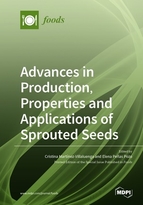Advances in Production, Properties and Applications of Sprouted Seeds
A special issue of Foods (ISSN 2304-8158). This special issue belongs to the section "Grain".
Deadline for manuscript submissions: closed (15 February 2020) | Viewed by 37144
Special Issue Editors
Interests: grains; peptides; phenolic compounds; nutritional characterization; protein quality and digestibility; bioavailability of food compounds; bioactivity; germination; fermentation; enzymatic treatments
Special Issues, Collections and Topics in MDPI journals
Interests: grains; germination; fermentation; nutritional value; bioactive compounds; food quality and safety; gluten-free grain-derived products; celiac disease
Special Issues, Collections and Topics in MDPI journals
Special Issue Information
Dear Colleagues,
Sprouted grains, usually designated as a seed with a visible radicle, have been used as food ingredients for many years, based on the general belief they provide significant nutritional, flavor, and textural benefits over ungerminated seed counterparts. In recent years, sprouting has been explored as a promising green food engineering strategy to improve the nutritional value of grains as well as to synthesize secondary metabolites with potential application in the functional foods, nutraceutical, pharmaceutical, and cosmetic markets. In this context, the industry has increasingly launched products containing or made of sprouted seeds.
During seed sprouting, a multitude of changes occur, moving from molecular to macroscopic structures. Sprouting reactivates seed metabolism leading to the catabolism and degradation of macronutrients and antinutritional compounds and the biosynthesis of secondary metabolites with potential health benefits. These changes impact the nutritional value and health-promoting potential of edible seeds. Many researchers around the world have proposed successful strategies such as elicitation to find the optimal environmental conditions during sprout growth able to promote desired outcomes.
At present, studies on seed germination are at the interface of multiple disciplines, including plant physiology, agronomy, and (bio)chemistry, and their several connections with food science and technology, pharmacology, and medicine. The Special Issue “Advances in Production, Properties, and Applications of Sprouted Seeds” has the potential to disseminate the recent cross-disciplinary approaches on seed germination with coverage from grains to products. Therefore, original research papers and review articles addressing recent advances in food science and technology with a deeper insight into strategies of seed sprouting, elicitation mechanisms, analysis of nutritional value, and phytochemical composition of sprouts in production or storage, evaluation of bioactive and technofunctional properties, and new applications of sprouted seeds or products derived thereof are particularly welcome.
Dr. Cristina Martínez-Villaluenga
Dr. Elena Peñas Pozo
Guest Editors
Manuscript Submission Information
Manuscripts should be submitted online at www.mdpi.com by registering and logging in to this website. Once you are registered, click here to go to the submission form. Manuscripts can be submitted until the deadline. All submissions that pass pre-check are peer-reviewed. Accepted papers will be published continuously in the journal (as soon as accepted) and will be listed together on the special issue website. Research articles, review articles as well as short communications are invited. For planned papers, a title and short abstract (about 100 words) can be sent to the Editorial Office for announcement on this website.
Submitted manuscripts should not have been published previously, nor be under consideration for publication elsewhere (except conference proceedings papers). All manuscripts are thoroughly refereed through a single-blind peer-review process. A guide for authors and other relevant information for submission of manuscripts is available on the Instructions for Authors page. Foods is an international peer-reviewed open access semimonthly journal published by MDPI.
Please visit the Instructions for Authors page before submitting a manuscript. The Article Processing Charge (APC) for publication in this open access journal is 2900 CHF (Swiss Francs). Submitted papers should be well formatted and use good English. Authors may use MDPI's English editing service prior to publication or during author revisions.
Keywords
- seed germination
- elicitation
- nutritional value
- phytochemicals
- bioactivity
- health
- food safety
- technological properties
- food development
- functional foods








